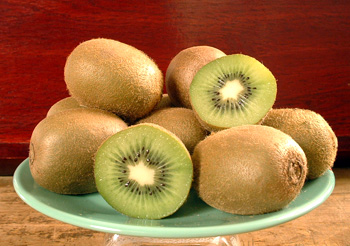 Kiwis
Kiwis© Denzil Green
Kiwi is a fruit that grows on a woody vine and has a hairy, brown skin. But inside, when sliced, it has a striking green flesh surrounding a ring of small black seeds.
Everything inside, including the seeds, is edible. The rough kiwi skin is actually edible, too: it has a slightly bitter, lemony taste.
The New Zealand season for growing iiwi is exactly opposite that of California’s; the result is that, in tandem with each other, the two growing sources are able to keep North America supplied with Kiwi year round.
New Zealand has developed a new variety of Kiwi, ZESPRI™ Gold which has yellow-coloured flesh inside, and a hairless brown skin.
Cooking Tips
If you are just eating a Kiwi yourself (as opposed to slicing it for a salad, say), there is no need to peel it. Just cut it in half, and eat it just as you would a boiled egg, using a spoon.
Nutrition
Very rich in vitamin C. The skin is rich in fibre and anti-oxidants.
In June 2004, scientists at Southampton University, England, found that some children under 6 can have allergic reactions to Kiwi fruit.
Equivalents
1 medium Kiwi fruit = 5 to 6 slices – ½ cup slices
2 slices, peeled = ½ oz = 15g
Storage Hints
Kiwis keep well in cold storage for several months.
History Notes
Native to the Yangtze Valley in China, where it is called “Yang Tao”, it was never actually cultivated until a British botanist brought some samples to the west in 1900. By 1906, New Zealand began growing them as a commercial crop.
First become popular in North America starting in the early 1960s in California. It was called a Chinese Gooseberry at the time, but was then renamed Kiwi after the bird because of the fruit’s brown skin. The change of name was a marketing ploy, but it worked, and sales of the fruit skyrocketed.
By the mid 1980s, Kiwi had become the hot food item in both North America and the UK.
Sources
Mainland, Charles M. and Connie Fisk. Kiwifruit . Department of Horticultural Science, North Carolina State University. 2006.

